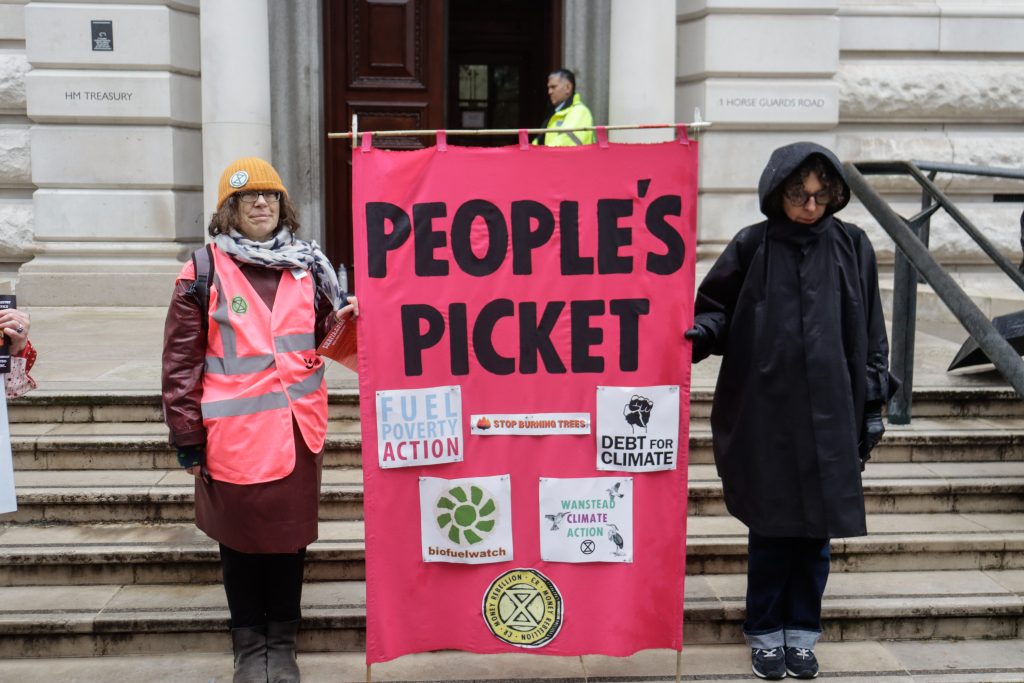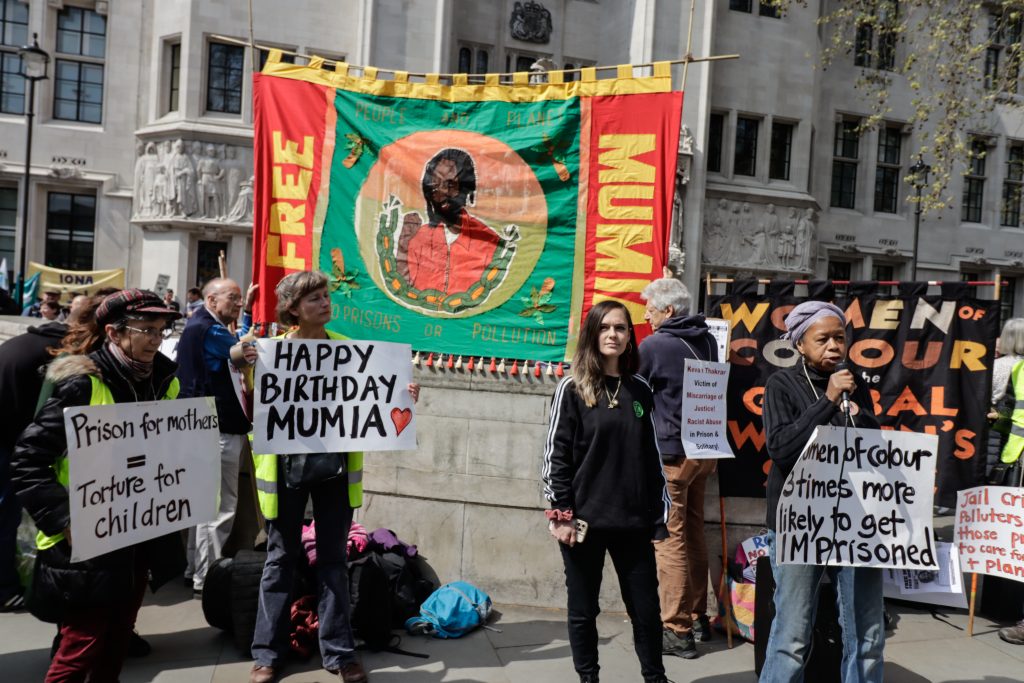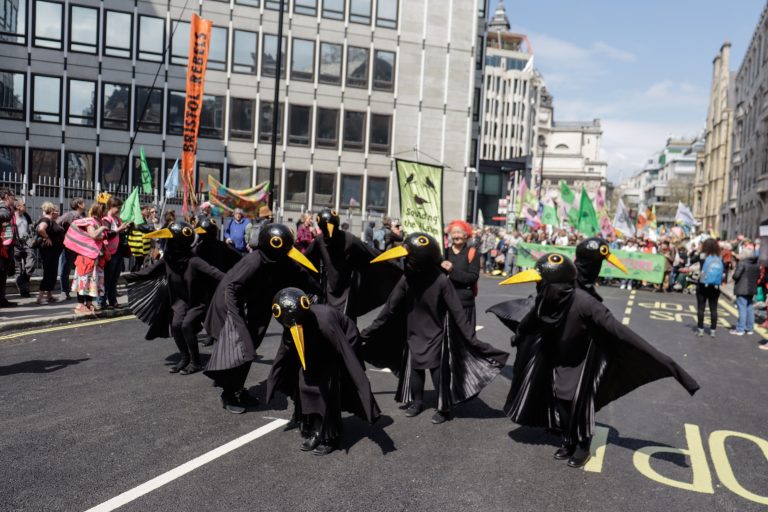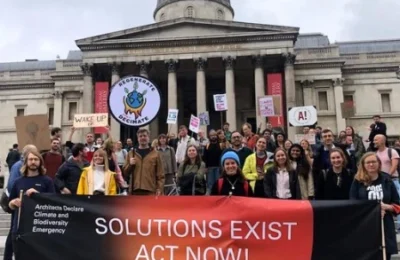This was a result of XR’s declared shift in emphasis away from disruptive activities towards coalition building and growing and broadening the environmental movement.
It also meant XR attempting actively to engage with other forces around cost of living campaigns, the recent strike wave (largely through the exemplary work of Extinction Rebellion Trade Unionists XRTU) and the opposition to draconian anti-protest and anti-strike legislation.
Our friends at RS21 produced an analysis of The Big One (below), with which we largely agree. However, I would add a note about some of the weaknesses and potential problems for the movement going forward.
As noted above, Extinction Rebellion went a long way in framing its demands and actions in the context of the ongoing cost of living crisis and made overtures towards the broader labour movement.
Unfortunately this was largely unreciprocated and very few of the 200 or so sponsoring organisations can be in any way identified as Labour movement bodies. Notable by its absence in particular was SERA, Labour’s environmental organisation which neither sponsored The Big One nor sent out any publicity, as far as we can tell, inviting supporters to attend!
Furthermore, on the major set-piece demonstration of Saturday 22nd April, when 60,000 people hit the streets, there were barely any movement banners or organised contingents. Yes, there were a couple of Unite Community banners and a local UCU branch banner- no national ones were in evidence. I also saw no Labour CLP or branch banners at all, which is quite unusual.
Of course there were many trade unionists and Labour Party members there as individuals. John McDonnell MP was a welcome presence, and there may have been others.
However, if Labour nationally is attempting to seize the green agenda and put forward a radical set of environmental proposals (as it should), this is not sufficient. These policies will have to be actively promoted and fought for within the broader movement- the Party as well as key trade unions- not just in the media and at the ballot box.
This is something which should be able to unite all wings of the party and provide the sort of inspiration to a new layer of young activists which we haven’t seen since the radical, insurgent manifesto of 2017.
XR’s April actions saw the biggest mobilisation in British environmentalist history, but the organisation is grasping for clarity going forward. Gus Woody reports on the Big One and identifies the strategic interventions that would help environmentalists win. This article features photographs by Steve Eason.

Extinction Rebellion (XR) caused a minor scandal when they began the year with the message ‘We Quit’. The announcement that they would shift away from certain forms of direct-action tactics was coupled with their new campaign – ‘Unite to Survive’. The goal was simple, XR would spend the next few months working across groups to build a coalition capable of bringing 100,000 people to Parliament in April.
The weekend of 21-24 April saw the culmination of this process. An estimated 60,000 people came to London for action and over 200 groups participated in mobilisations over the four days. This was an impressive result for an admittedly small time period to bring together groups and activists, showing a movement capable of some self-reflection.

On Friday 21 and Monday 24 April, groups spent the day organising ‘people’s pickets’ outside various Government buildings. These were open to not just XR groups, but any group interested in working around the days of action. rs21 comrades helped organise the Home Office picket, along with XR Cambridge, XR Colchester, XR Cardigan, and West Wales Climate Coalition.
These ‘pickets’ became focus spaces for interventions around particular government buildings. For example, Housing Rebellion, a new XR housing-focused offshoot, spent much of their time outside the Department for Levelling Up, Housing, and Communities, discussing the interrelation between the housing crisis, emissions from buildings and lack of green space.

The Home Office picket saw the leafletting of many employees of the Department as they went into work, left for meals and went home. The leaflet talked about the need to dismantle the border system as a climate struggle, with many workers responding positively to it, stoping to talk and express support with the picket. Similarly, there was a commitment from across the XR groups to join Civil Service members of the PCS union on their forthcoming strike date on 28 April.
At the Home Office ‘picket’, rs21 members held three different workshops. Firstly, a discussion about the ‘right to strike’ and the Conservative’s attack on it with the Minimum Services Bill. This was to open a conversation about how XR groups could support local picket lines, whether engaging in strategic direct action to escalate disputes, visiting pickets or fundraising for strike funds.
In addition to this, a workshop was organised on dismantling the border system, particularly highlighting the need to resist the Illegal Immigration Bill – which continues a trend of effectively shutting down asylum status. Finally, a workshop was run on the wider assaults on the right to protest occurring over the last few years. This highlighted the need to resist the escalating state repression coming from the Home Office.

Across the weekend several large-scale mobilisations occurred. On Saturday the march for biodiversity saw the largest mobilisation of people in British environmental movement history, coming around the 60,000 person mark. Despite this large number, it was met with widespread silence from the capitalist press, who seem more interested in sensationalising certain actions than covering the true extent of the climate crisis.



On Sunday, thousands of letters were written to MPs expressing opposition to the racist and xenophobic Illegal Immigration Bill. These were folded into paper boats and floated in the water in front of the Home Office. They were then re-collected and sent to the various MPs encouraging them to oppose the bill.
XR Trade Unionists organised a Trade Union Hub on the Saturday, with workers from various disputes and trade union climate networks speaking. This gave space for XR members to consider how to align their commitment to direct action with the ongoing strike wave, opening space for increasing solidarity between workers and the militant wing of the environmental movement.
At the ‘What’s Next?’ assembly, a discussion was held about what Extinction Rebellion groups’ strategy should be going forward. Three options were presented to the thousands at this assembly: a strategy focused on supporting pickets and the strikewave, a strategy around local organising in communities, and a focus on mass civil disobedience. This latter focus on civil disobedience won the day, with around 80% of those present opting for this.
Where now?
Extinction Rebellion is at a crossroads. Flanked on one side by the conservative politics of NGOs like Greenpeace and on the other side by the more evangelical direct-action crews of Just Stop Oil, it has engaged in a period of self-reflection, but a general uncertainty has gripped many of its members.
Many engaged in mass direct action since 2018 have been frustrated that it didn’t result in the straightforward shift in ecological policy that was expected. One fraction of activists feel frustrated at the lack of a wider social base supporting their direct action, feeling that this suggests a need to engage in more focused ‘community’ organising to build support. Others feel that the issue is merely the targeting or scale of the direct action, opting to throw their lot in with Insulate Britain and Just Stop Oil.
The intervention of ecosocialists in this space is twofold. With those inclined towards ‘community’ organising, there is a need to share the skills and strategic knowledge we have around its actual complexity. From organising renters to organising workplaces, we know that work amongst the masses is far more complicated than the often-naive view of simply organising the amorphous mass referred to as the community. Our role is to strengthen the militant wing of XR interested in organising the working class around a programme of environmental action, that takes seriously the difficult work of organising on class lines.
The other area of intervention is around those who wish to continue to escalate forms of direct action. There is a need to ensure that this work is targeted at the British state and fossil capital, rather than the wider public at large. The Marxist tradition has for a long time insisted on work with the masses rather than adventurist action by a minority, which is ultimately used to justify wider repression. This is not to oppose direct action or ignore its urgency, but to insist on its tactical and strategic link with the mass organising of the workers and exploited.
Time will tell what comes of XR’s period of self-reflection. Overall, environmentalists are facing a growing wave of state repression, with two Just Stop Oil activists recently facing over two years of custodial sentences each. Without both smarter direct action and the building of mass support, this movement will flounder and risk catastrophic losses.



